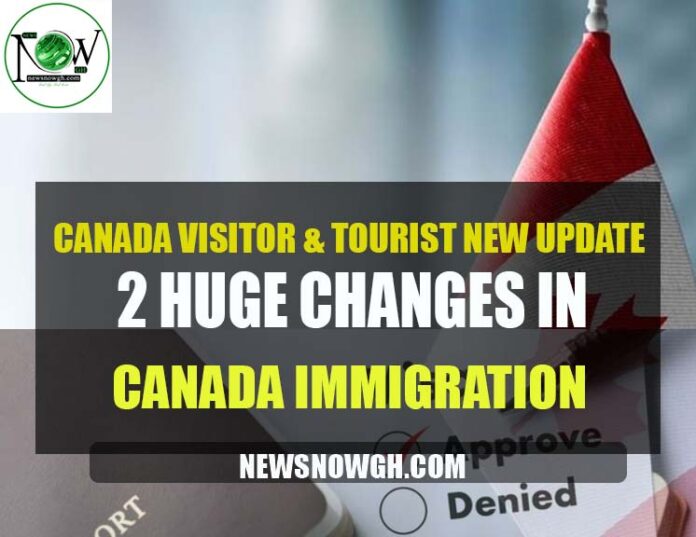2 Huge Changes in Canada Immigration: Canada Visitor & Tourist New Update
In this blog, we’ll talk about two significant recent developments that affect Canada’s policies regarding guest visas and permanent residency. Continue reading to learn more about how these changes may impact anyone you know considering immigration or a trip to Canada.
1. Changes in Permanent Residency (PR) Category
Canada’s immigration laws are always changing to accommodate the nation’s changing demographics and economic needs. Restructuring the categories of permanent residency to meet better the needs and expectations of the growing labor market is one of the most notable recent reforms.
Healthcare Occupations
The most recent PR allocations favored careers in the healthcare industry, increasing the number of open opportunities from 30% to 45%. With the aging population and growing public health issues, Canada has recognized the essential role healthcare professionals play in preserving the nation’s healthcare system, as evidenced by this adjustment.
A broad spectrum of professions, including physicians, nurses, pharmacists, physiotherapists, medical laboratory technologists, and more, are covered by the increased PR prospects for healthcare professionals. These specialists are highly sought after throughout Canada and play a crucial role in the nation’s healthcare system.
Information Technology (IT) Fields
PR allotments to the IT industry have increased from 25% to 30%. This shift is a reflection of Canada’s increasing focus on technology-driven industries and its requirement for IT specialists with advanced skills to facilitate innovation and digital transformation.
Aiming to alleviate labor shortages and stimulate technical growth across numerous sectors of the Canadian economy, expanded PR possibilities are beneficial to skilled IT workers, including software developers, network engineers, data analysts, and cyber security specialists.
Trade and Technical Occupations
PR allocations for trade jobs like mechanics and technicians have changed to accommodate industry demands. These positions are crucial to Canada’s manufacturing, construction, and automotive industries, as they guarantee the vital industries’ continuous expansion and effectiveness.
In their particular industries, skilled tradespeople such as electricians, welders, plumbers, and automotive technicians are essential to the upkeep of infrastructure and the creation of jobs. The goal of the updated PR categories is to draw and keep talent in these important professions.
Transportation Sector
PR allocations have also changed in the transportation industry, notably for jobs like truck drivers and heavy vehicle operators. These changes are intended to meet particular labor market demands and guarantee the smooth transportation of products and services throughout Canada’s large territory.
Competent operators and drivers facilitate trade and commerce across national and international borders, making a substantial contribution to the logistics and transportation sector. For seasoned professionals, more PR opportunities offer a route to permanent residency in Canada.
Agriculture and Agri-food Sector
Even if they make up only 5% of all PR allotments, jobs in agriculture are nevertheless essential to Canada’s food security and sustainability. The success of Canada’s agriculture and agri-food industry is largely due to skilled personnel in this field, such as farm managers, agricultural technicians, and food inspectors.
The PR categories’ inclusion of jobs in the agriculture sector demonstrates Canada’s dedication to assisting rural areas and maintaining a strong food supply chain. These experts are essential to keeping Canada at the top of the world agricultural production rankings.
All things considered, the adjustments to PR classifications are indicative of Canada’s strategic immigration policy, which places a premium on jobs that foster innovation, economic expansion, and social progress. Canada seeks to attract and retain qualified people who can contribute to the Prosperity of the country by matching PR allocations with labor market demands.
2. Changes in Visitor and Tourist Visa Criteria
Not only have PR categories been updated, but the requirements for visitor and tourist visas to Canada have also recently changed. The purpose of these changes is to improve the visa application process’s efficiency, fairness, and transparency.
Clearer Guidelines for Visa Assessments
In the past, uneven results were frequently attributed to immigration officers’ subjective decision-making when they rejected visa applications. The most recent modifications remove uncertainty and improve predictability in the decision-making process by introducing more precise guidelines and objective standards for evaluating visa applications.
Now, applicants can take advantage of more open and consistent evaluation processes that concentrate on objective elements including financial stability, ties to the applicant’s home country, and travel ambitions. This change attempts to lessen the possibility of unfair denials and enhance the overall experience for visa applicants.
Addressing Root Causes of Visa Rejections
Recently, a petition calling for the reintroduction of Bill C-91 was sent to the Montreal Quebec House of Commerce. The program aims to improve the efficiency of visa processing and remove unnecessary obstacles to travel by addressing the underlying reasons why legal travelers get their visas denied.
Immigration officers’ instructions and policy modifications methodically address common reasons for visa rejections, such as unclear travel schedules or insufficient evidence of ties to the home country. Canada hopes to resolve these problems to streamline the visa application process and encourage tourism and travel abroad.
Balancing Security Concerns with Visitor Welcome
Canada’s commitment to finding a balance between security concerns and allowing lawful visitors is reflected in the modifications and the visa requirements. Through the implementation of more precise rules and the resolution of frequently encountered rejection factors, Canada hopes to establish itself as a top destination for tourists wishing to experience its varied landscapes and cultural offers.
These modifications demonstrate Canada’s commitment to upholding an equitable, effective, and transparent visa application procedure that promotes lawful travel and tourism while defending the country’s interests.
Conclusion
The most recent adjustments to Canada’s immigration laws show a calculated attempt to maximize PR allotments and expedite the visa evaluation process. Canada seeks to provide a friendly and inclusive environment for talented workers, tourists, and visitors by coordinating immigration laws with economic interests and demands for international travel.


